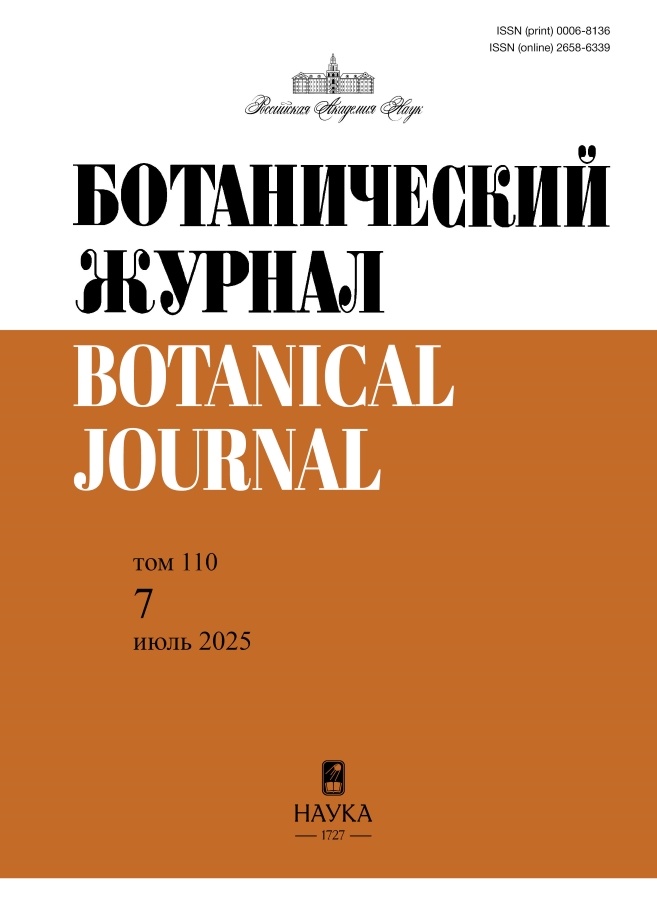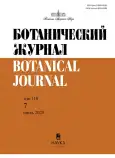Botanical Journal
Journal is founded by the Branch of Biological Sciences RAS and the Russian Botanical Society (RBO) in December 1916. Published by Akademkniga Publishers.
«Botanicheskii Zhurnal» is a leading Russian scientific periodical publishing results of the studies in the field of fundamental botany.
«Botanicheskii Zhurnal» (the Journal) publishes the results of studies in various areas of fundamental botany: theoretical papers and reviews; original research; systematic reviews; descriptions of new taxa and most interesting floristic findings; novel methods in botanical studies; articles on flora conservation; reviews on major Russian and international publications in botany; information on scientific events (symposia, conferences, etc.); personalia; information on the activities of the Russian Botanical Society (RBO), major botanical news and botanical travels; articles on the history of botany.
ISSN (print): 0006-8136, ISSN (online): 2658-6339
Media registration certificate: № 0110163 от 04.02.1993
Founders: Russian Academy of Sciences; Russian Botanical Society
Editor-in-chief: Averyanov Leonid Vladimirovich
Number of issues per year: 12
Indexation: Higher Attestation Commission list, RISC, RISC core, RSCI, White list (3rd level), Crossref, SCOPUS.
最新一期
卷 110, 编号 7 (2025)
REVIEWS
Trimonoecy in flowering plants
摘要
Trimonoecious plant populations consist of individuals that have staminate, pistillate, and perfect flowers. Trimonoecy is very rare in angiosperms, and knowledge about it is extremely sparse. Based on literature data and personal research, a list of trimonoecious plants in the world flora has been compiled, which includes 73 species from 44 genera belonging to 29 families and 19 orders of angiosperms. Trimonoecy occurs in 6.9% of families, 0.3% of genera, and 0.025% of species in angiosperms. Trimonoecious species have not been identified in the group of basal angiosperms and magnoliids. The highest proportion of trimonoecious species occurs within the monocots: 20.0% of families, 0.7% of genera, and 0.05% of species, while the vast majority of trimonoecious plants (80.3% of all species) are found among the Superrosids (27 species) and Superasterids (32 species). Five families are particularly noted for having trimonoecious species: Apiaceae (16 species from 2 genera), Amaranthaceae (7 species from 3 genera), Cleomaceae (6 species from 2 genera), Commelinaceae (5 species from 1 genus), and Poaceae (4 species from 4 genera). Slightly less than half of all trimonoecious species belong to five genera: Heracleum L. (13 species), Aneilema R.Br. (5), Cleome L. (5), Amaranthus L. (4), and Lomatium Raf. (3). The relationship and possible correlation of trimonoecy with such biological and ecological characteristics as life form, mode of pollination, perianth color, pericarp consistency, presence of related monoecious taxa, geographical latitude of occurrence, and distribution along floristic phytochorions has been analyzed and is presented herein. The article ultimately discusses the dimensional differences in the perianths of the three flower types, pollen fertility and pollen productivity of perfect and staminate flowers, the location and ratio of perfect, staminate, and pistillate flowers on individuals, as well as the mechanisms of the origin and evolution of trimonoecy in angiosperms.
 619-633
619-633


COMMUNICATIONS
Flora of diatoms (Bacillariophyta) in coastal biotopes of Nalychevo Lake (eastern Kamchatka)
摘要
The study of materials from littoral biotopes of Nalychevo Lake (“Nalychevo” Natural Park, Eastern Kamchatka) using scanning electronic microscopy revealed 164 taxa of diatoms from 57 genera, including new ones to the flora of Russia: Cocconeis pseudothumensis, Cymbopleura acutiformis, Encyonema subminutum, Gomphonema cf. khienticense, and Witkowskia parvapolonica. 15 algae have been identified to the genus only, namely Achnanthidium, Amphora, Caloneis, Cocconeis, Encyonema, Fragilaria, Gomphonema, Navicula, Pinnularia, Placoneis, Planothidium, Sellaphora. The obtained data have significantly expanded taxonomic spectrum of Bacillariophyta in the lake: from 35 to 189 species and varieties, and from 18 to 58 genera. The most taxonomically diverse are the genera Achnanthidium (8 taxa), Navicula (13) and Gomphonema (16). Ecological analysis of the flora of Bacillariophyta from biotopes with agglomerations of Aegagropila colonies of various ages has shown that the vast majority of discovered algae prefer fresh, subalkaline water bodies. According to saprobity index, the surveyed littoral areas of the lake are classified as oligosaprobic with elements of mesosaprobity.
 634-648
634-648


Ecological Study of Epiphytic Lichens on Pistachio (Pistacia atlantica) in Sub-Mediterranean Formations of the Utrish Reserve (North-Western Caucasus)
摘要
The article presents the results of a study of epiphytic lichens growing on the Mediterranean-Western Asian species Atlantic pistachio (Pistacia atlantica) in the Utrish Nature Reserve, located in the Abrau Peninsula, Northwest Caucasus (Krasnodar Territory, Russia). Based on the material collected by the authors in 16 sites in 2014—2024, 184 epiphytic species from 102 genera were recorded, including 159 lichen species, 3 non-lichenized saprobic fungi, and 22 lichenicolous fungi. Predominating are the taxa with a crustose and squamose growth form or without a lichenized thallus (127 species), and the macrolichens with a foliose, fruticose or placoid growth form (57 species). A significant share of the species (40%) are rare and were found in 1-2 sites, whereas almost 10% of the widespread species were recorded in 15-16 sites. Fifty-two species are new to the lichen flora of the Utrish Reserve. Among them, 5 species (Bacidia iberica, Blastenia coralliza, Ochrolechia dalmatica, Pertusaria paramerae, Stigmidium hageniae) are new to Russia, 4 species (Catapyrenium psoromoides, Opegrapha lamyi, Phacothecium varium, Sphaerellothecium parietinarium) were found for the first time in the Caucasus, and 24 species and 6 genera (Dichoporis, Phacothecium, Piccolia, Reichlingia, Telogalla, Thelenella) are new to the Krasnodar Territory.
 649-670
649-670


Riparian-aquatic vegetation of the north-western Ladoga area (Leningrad region)
摘要
The article presents the diversity of riparian-aquatic communities in the north-western part of Ladoga within the Leningrad Region: 5 groups of associations (Phragmiteta australis, Equiseteta fluviatilis, Glycerieta maximae, Cariceta acutae, Comareta palustris), 14 associations and 5 variants of associations. Four associations (ass. Phragmitetum australis–Glycerietum maximae, ass. Caricetum acutae–Glycerietum maximae, ass. Comaretum palustris–Caricetum cespitosae, ass. Comaretum palustris–Caricetum lasiocarpae) were not previously reported for the skerry region of Ladoga Lake, but were described for other regions of the European part of Russia. Mapping of the riparian-aquatic vegetation was carried out, verification using high-resolution images and field verification of the selected contours allowed reliable deciphering the communities Aquiherbosa, Equiseteta fluviatilis and Phragmiteta australis.
 671-693
671-693


Anther formation in some species of genus Echeveria (Crassulaceae)
摘要
Echeveria species are characterized by both common and specific features in the anther structure. They, like most members of the Crassulaceae family, have basic characteristics associated with reproductive processes. These include: tetrasporangiate anther, parietal tapetum, predominantly tetrahedral tetrads of microspores, 2-celled and 3-colporate mature pollen grains. The studied species form different alliances: according to the anther shape – almost isobilateral (symmetrical) in E. gibbiflora and E. pulvinata and asymmetrical in E. puchella and E. pulidonis, which correlates with the contour of the microsporangium cavities; according to the shape of the layer of cells with thickened walls around the vascular bundle of the connective tissue – ring-shaped in E. gibbiflora and E. pulvinata and an oval in E. puchella and E. pulidonis; according to the tapetum structure – irregularly 2-layered in E. gibbiflora and E. pulidonis, 2-layered in E. pulvinata, and single-layered in E. puchellia; according to time of destruction of the walls between tapetum cells – at the stage of microspore tetrads in E. gibbiflora, E.puchella and E. pulvinata, of single microspores in E. pulidonis; according to the endothecium structure – cells begin to increase radially at the beginning of meiosis in E. pulvinata, at the tetrad stage in E. puchella, at the tetrad and early single microspore stages in E. gibbiflora and E. pulidonis. Some characters (symmetrical anthers with a 4-rayed connective tissue) reveal similarities with species of the genera Aeonium, Monanthes and Sedum. Based on the presence of fibrous thickenings in the cells (in addition to the typical layer based on the subepidermis of the microsporangium wall, additional layers appear in the connective tissue), Crassula joins the above-mentioned genera. The study revealed a mosaic distribution of anther structural traits in the genus Echeveria. It is likely that the studied species are characterized by a complex of multidirectional signs. The species form groupings depending on the analyzed properties, while each species does not have a set of traits inherent only to it. This conclusion does not contradict molecular genetic studies. Despite the similarity of some structural features, the species we studied belong to different clades of the “Echeveria group”.
 694-714
694-714


PROTECTION OF PLANT WORLD
RARE SPARSE SPRUCE FORESTS (PICEA OBOVATA) WITH MOSS AND LICHENS: UNIQUE FOREST COMMUNITIES OF THE OKA PLATEAU (EAST SAYAN, BURYATIA)
摘要
In course of field work in the Okinsky District of Buryatia (July 2023), an expedition team from Moscow State University and Main Botanical Garden of the Russian Academy of Sciences discovered and initially examined rare old-growth sparse spruce forests with moss-lichen (Rhytidium rugosum – Cladonia spp.) bottom layer on lavas in the Zhom-Bolok River valley (Oka Plateau, East Sayan). In July 2024, the 2nd expedition revisited and explored the forests in the area in more detail. The paper provides the first collected data on these unique communities (including a complete relevé of one of them). The differences between these communities and lichen/moss-lichen spruce forests from other regions of Russia are discussed in details. The plan to investigate these forest communities and to elaborate measures for their protection is envisaged. The spruce moss-lichen woodlands of the Oka Plateau meet both the IUCN Red List of Ecosystems and the Russian regional criteria for rare and endangered ecosystems.
 715-726
715-726












